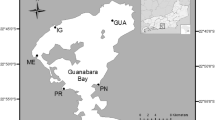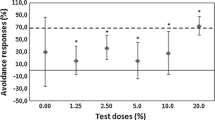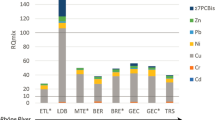Abstract
Purpose
The toxicity of 36 dredged sediments from the Czech Republic was investigated using a large battery of bioassays. The aim of this study was to investigate the feasibility of ecotoxicity testing in general and of individual bioassays more specific and to investigate how the results of bioassays are determined by the physicochemical properties of sediment samples and/or sediment contamination.
Material and methods
In 2008 and 2010, 36 sediment samples were collected from rivers and ponds and from sediment heaps in different parts of the Czech Republic. Both their physicochemical properties and their levels of contamination with POPs and heavy metals were analyzed. The ecotoxicities of the sediments were evaluated using the four bioassays from the new Czech directive 257/2009 Coll. concerning the application of dredged sediments on agricultural land (Enchytraeus crypticus reproduction, Folsomia candida reproduction, Lactuca sativa root elongation, and potential ammonium oxidation). The results of the four directive bioassays were compared with the results of other soil bioassays (Caenorhabditis elegans mortality, Eisenia fetida avoidance and reproduction) and eluate bioassays (Daphnia magna immobilization, Pseudokirchneriella subcapitata growth inhibition test, and Vibrio fischeri luminescence).
Results and discussion
We demonstrate that the battery suggested in Czech directive 257/2009 Coll. is highly effective in identifying toxic samples; these bioassays clearly revealing different types of toxicity and different exposure routes. Shorter alternative bioassays may be added especially when fast toxicity identification is needed. Eluate bioassays identified samples potentially hazardous to aquatic ecosystems. Their inclusion into the assessment scheme should be considered if the goal of assessment is also the protection of aquatic ecosystems. The results of our multivariate analysis show that specific physicochemical properties and contamination may affect bioassay responses. C. elegans was the most sensitive bioassay to physicochemical properties and also to organic contamination, while eluate bioassays were sensitive to heavy metal pollution.
Conclusions
Most effects detected by the bioassays could not be explained by the levels of toxicants measured or by the natural characteristics of sediments. Our results show that bioassays are irreplaceable in dredged sediment risk assessment because they complement information provided by chemical analyses.



Similar content being viewed by others
References
Ahlf W, Hollert H, Neumann-Hensel H, Ricking M (2002) A guidance for the assessment and evaluation of sediment quality - a German approach based on ecotoxicological and chemical measurements. J Soils Sediments 2:37–42
Amorim MJB, Römbke J, Soares AMVM (2005) Avoidance behavior of Enchytraeus albidus: effects of Benomyl, Carbendazim, phenmedipham and different soil types. Chemosphere 59:501–510
ASTM E2172 – 01 (2008) Standard guide for conducting laboratory soil toxicity tests with the nematode caenorhabditis elegans. American Society for Testing and Materials, Philadelphia
Babut M, Perrodin Y (2001) Ecotoxicological assessment of contaminated sediments and dredged material. Voies Navigables de France, Centre d’Etudes Techniques Maritimes et Fluviales (in French)
Barcelo D, Petrovic M (2007) Soil protection, sediment monitoring and key recommendations. In: Barcelo D, Petrovic M (eds) Sustainable management of sediment resources - sediment quality and impact assessment of pollutants, 1st edn. Elsevier, Amsterdam
Bezchlebová J, Černohlavková J, Lána J, Sochová I, Kobětičová K, Hofman J (2007) Effects of toxaphene on soil organisms. Ecotoxicol Environ Saf 68:326–334
Chen YX, Zhu GW, Tian GM, Zhou GD, Luo YM, Wu SC (2002) Phytotoxicity of dredged sediment from urban canal as land application. Environ Pollut 117:233–241
Czerniawska-Kusza I, Ciesielczuk T, Kusza G, Cichon A (2006) Comparison of the Phytotoxkit microbiotest and chemical variables for toxicity evaluation of sediments. Environ Toxicol 21:367–372
Domene X, Alcaniz JM, Andres P (2007) Ecotoxicological assessment of organic wastes using the soil collembolan Folsomia candida. Appl Soil Ecol 35:461–472
Eijsackers H (2010) Earthworms as colonizers: primary colonization of contaminated land, and sediment and soil waste deposits. Sci Total Environ 408:1759–1769
Eijsackers H, Bruggeman J, Harmsen J, de Kort T, Schakel A (2009) Colonization of PAH-contaminated dredged sediment by earthworms. Appl Soil Ecol 43:216–225
EN 14735 (2007) Characterization of waste - Preparation of waste samples for ecotoxicity tests. Czech Normalisation Institute, Prague
Ezekiel M (1930) Methods of correlation analysis. Wiley, New York
Höss S, Bergtold M, Haitzer M, Traunspurger W, Steinberg CEW (2001) Refractory dissolved organic matter can influence the reproduction of Caenorhabditis elegans (Nematoda). Freshwater Biol 46:1–10
Höss S, Jansch S, Moser T, Junker T, Rombke J (2009) Assessing the toxicity of contaminated soils using the nematode Caenorhabditis elegans as test organism. Ecotox Environ Safe 72:1811–1818
Höss S, Ahlf W, Fahnenstich C, Gilberg D, Hollert H, Melbye K, Meller M, Hammers-Wirtz M, Heininger P, Neumann-Hensel H, Ottermanns R, Ratte H-T, Seiler T-B, Spira D, Weber J, Feiler U (2010) Variability of sediment-contact tests in freshwater sediments with low-level anthropogenic contamination - Determination of toxicity thresholds. Environ Pollut 158:2999–3010
ISO 10872 (2010) Water quality—determination of the toxic effect of sediment and soil samples on growth, fertility and reproduction of Caenorhabditis elegans (Nematoda). ISO guideline 10872. International Organization for Standardization, Geneva
ISO 11267 (1999) Soil quality—inhibition of reproduction of Collembola (Folsomia candida) by soil pollutants. ISO guideline 11267. International Organization for Standardization, Geneva
ISO 11268–2 (1998) Soil quality—effects of pollutants on earthworms (Eisenia fetida). Part 2: determination of effects on reproduction. ISO guideline 11268–2. International Organization for Standardization, Geneva
ISO 11269–1 (1993) Soil quality—determination of the effects of pollutants on soil flora. Part 1: method for the measurement of inhibition of root growth. ISO guideline 11269–1. International Organization for Standardization, Geneva
ISO 15685 (2004) Soil quality—determination of potential nitrification and inhibition of nitrification—Rapid test by ammonium oxidation. ISO guideline 15685. International Organization for Standardization, Geneva
ISO 15799 (2003) Soil quality—guidance on the ecotoxicological characterization of soils and soil materials. ISO guideline 15799. International Organization for Standardization, Geneva
ISO 16387 (2004) Soil quality—effects of pollutants on Enchytraeidae—determination of effects on reproduction and survival. ISO guideline 16387. International Organization for Standardization, Geneva
ISO 17512–1 (2008) Soil quality—avoidance test for determining the quality of soils and effects of chemicals on behavior. Part 1: Test with earthworms (Eisenia fetida and Eisenia andrei). ISO guideline 17512–1. International Organization for Standardization, Geneva
ISO 17616 (2008) Soil quality—guidance on the choice and evaluation of bioassays for ecotoxicological characterization of soils and soil materials. ISO guideline 17616. International Organization for Standardization, Geneva
ISO 6341 (1996) Water quality—determination of the inhibition of the mobility of Daphnia magna Straus (Cladocera, Crustacea)—acute toxicity test. ISO guideline 6341. International Organization for Standardization, Geneva
ISO 8692 (2004) Water quality—freshwater algal growth inhibition test with unicellular green algae. ISO guideline 8692. International Organization for Standardization, Geneva
ISO11348-3 (1998) Water quality—determination of the inhibitory effect of water samples on the light emission of Vibrio fischeri (Luminescent bacteria test)—Part 3: Method using freeze-dried bacteria. ISO guideline 11348–3. International Organization for Standardization, Geneva
Juvonen R, Martikainen E, Schultz E, Joutti A, Ahtiainen J, Lehtokari M (2000) A battery of toxicity tests as indicators of decontamination in composting oily waste. Ecotox Environ Safe 47:156–166
Kaneda S, Kaneko N (2002) Influence of soil quality on the growth of Folsomia candida (Willem) (Collembola). Pedobiologia 46:428–439
Lahr J, Maas-Diepeveen JL, Stuijfzand SC, Leonards PEG, Druke JM, Lucker S, Espeldoorn A, Kerkum LCM, van Stee LLP, Hendriks AJ (2003) Responses in sediment bioassays used in the Netherlands: can observed toxicity be explained by routinely monitored priority pollutants? Water Res 37:1691–1710
Legendre P (2007) Studying beta diversity: ecological variation partitioning by multiple regression and canonical analysis. J Plant Ecol 1:3–8
Lors C, Ponge JF, Aldaya MM, Damidot D (2010) Comparison of solid-phase bioassays and ecoscores to evaluate the toxicity of contaminated soils. Environ Pollut 158:2640–2647
Lors C, Ponge JF, Aldaya MM, Damidot D (2011) Comparison of solid and liquid-phase bioassays using ecoscores to assess contaminated soils. Environ Pollut 159:2974–2981
Mamindy-Pajany Y, Hamer B, Roméo M, Géret F, Galgani F, Durmisi E, Hurel C, Marmier N (2011) The toxicity of composted sediments from Mediterranean ports evaluated by several bioassays. Chemosphere 82:362–369
Manz W, Krebs F, Schipper C, Besten P (2007) Dutch–German Exchange (DGE) on dredged material. Part 5: Status of the ecotoxicological assessment of sediments and dredged material in Germany and the Netherlands - with a short description of the situation in Belgium, France and Great Britain Status. German Federal Ministry of Transport, German Federal Ministry for the Environment, Dutch Ministry of Transport, Dutch Ministry of Housing, Bonn, The Hague
MoA (2009) Direction No. 257/2009 Coll. for sediment use on agricultural soils. Ministry of Agriculture and Ministry of Environment of Czech Republic, Prague
Pandard P, Devillers J, Charissou AM, Poulsen V, Jourdain MJ, Férard JF, Grand C, Bispo A (2006) Selecting a battery of bioassays for ecotoxicological characterization of wastes. Sci Total Environ 363:114–125
Perez-Sirvent C, Martinez-Sanchez MJ, Molina J, Garcia-Lorenzo ML (2010) Toxicity of sediments and their leachates in samples from Portman Bay (Se, Spain). Fresenius Environ Bull 19:137–146
Schipper CA, Rietjens IMCM, Burgess RM, Murk AJ (2010) Application of bioassays in toxicological hazard, risk, and impact assessments of dredged sediments. Mar Pollut Bull 60:2026–2042
Steevens J, Kennedy A, Farrar D, McNemar C, Reiss M, Kropp R, Doi J, Bridges T (2008) Dredged material analysis tools—performance of acute and chronic sediment toxicity methods. US Army Corps of Engineers. Washington, DC
Traunspurger W, Haitzer M, Hoss S, Beier S, Ahlf W, Steinberg C (1997) Ecotoxicological assessment of aquatic sediments with Caenorhabditis elegans (nematoda)—A method for testing liquid medium and whole-sediment samples. Environ Toxicol Chem 16:245–250
Tuikka AI, Schmitt C, Höss S, Bandow N, von der Ohe PC, de Zwart D, de Deckere E, Streck G, Mothes S, van Hattum B, Kocan A, Brix R, Brack W, Barceló D, Sormunen AJ, Kukkonen JVK (2011) Toxicity assessment of sediments from three European river basins using a sediment contact test battery. Ecotox Environ Safe 74:123–131
Vácha R, Čechmanková J, Skála J, Hofman J, Čermák P, Sáňka M, Váchová T (2011) Use of dredged sediments on agricultural soils from viewpoint of potentially toxic substances. Plant Soil Environ 57:388–395
Van Straalen NM, Burghouts TBA, Doornhof MJ, Groot GM, Janssen MPM, Joosse ENG, Van Meerendonk JH, Theeuwen JPJJ, Verhoef HA, Zoomer HR (1987) Efficiency of lead and cadmium excretion in populations of Orchesella cincta (Collembola) from various contaminated forest soils. J Appl Ecols 24:953–968
Vandecasteele B, Samyn J, Quataert P, Muys B, Tack FMG (2004) Earthworm biomass as additional information for risk assessment of heavy metal biomagnification: a case study for dredged sediment-derived soils and polluted floodplain soils. Environ Pollut 129:363–375
Acknowledgments
Financial support from the Ministry of Agriculture (project QH 82083) and Ministry of Education (project CETOCOEN CZ.1.05/2.1.00/01.0001) is gratefully acknowledged.
Author information
Authors and Affiliations
Corresponding author
Additional information
Responsible editor: Jaco Vangronsveld
Electronic supplementary material
Below is the link to the electronic supplementary material.
ESM 1
(DOC 521 kb)
Rights and permissions
About this article
Cite this article
Vašíčková, J., Kalábová, T., Komprdová, K. et al. Comparison of approaches towards ecotoxicity evaluation for the application of dredged sediment on soil. J Soils Sediments 13, 906–915 (2013). https://doi.org/10.1007/s11368-013-0670-x
Received:
Accepted:
Published:
Issue Date:
DOI: https://doi.org/10.1007/s11368-013-0670-x




